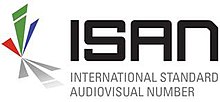International Standard Audiovisual Number: Difference between revisions
m →External links: Remove stuff that isn't a link, categorise |
→Number format: Not a-z, alphanumeric |
||
| Line 19: | Line 19: | ||
A root is assigned to a core work. Subsequent film parts or television episodes that relate to the root work can have the same root, but a different 'episode or part' component (if a core work does not have associated parts or episodes, then the episode segment is filled with zeros). Works (and their episodes or parts) that have been modified in some way — for example, dubbing, and subtitling the work into other languages — can have different versions. When the 96-bit ISAN is represented in [[hexadecimal]] form it has 24 digits, for example: 000000018947000000000000. |
A root is assigned to a core work. Subsequent film parts or television episodes that relate to the root work can have the same root, but a different 'episode or part' component (if a core work does not have associated parts or episodes, then the episode segment is filled with zeros). Works (and their episodes or parts) that have been modified in some way — for example, dubbing, and subtitling the work into other languages — can have different versions. When the 96-bit ISAN is represented in [[hexadecimal]] form it has 24 digits, for example: 000000018947000000000000. |
||
However, a printed ISAN designed for human reading always begins with the ISAN label, appears with hyphens to separate the number into more manageable groups of digits, and adds two check characters ( |
However, a printed ISAN designed for human reading always begins with the ISAN label, appears with hyphens to separate the number into more manageable groups of digits, and adds two check characters (alphanumeric) to help identify transcription errors. The resulting number appears as: ISAN 0000-0001-8947-0000-8-0000-0000-D |
||
ISAN-IA has also developed a recommended practice for encoding the ISAN in a [[two-dimensional barcode]] 96 [[pixel]]s square. |
ISAN-IA has also developed a recommended practice for encoding the ISAN in a [[two-dimensional barcode]] 96 [[pixel]]s square. |
||
Revision as of 12:58, 30 October 2008

For the band called ISAN, see Isan (band)
International Standard Audiovisual Number (ISAN) is a unique identifier for audiovisual works and related versions, similar to ISBN for books. It was developed within an ISO (International Organization for Standardization) TC46/SC9 working group. ISAN is managed and run by ISAN-IA.
The ISAN standard (ISO standard 15706:2002 & ISO 15706-2) is recommended or required as the audiovisual identifier of choice for producers, studios, broadcasters, Internet media providers and video games publishers who need to encode, track, and distribute video in a variety of formats. It provides a unique, internationally recognized and permanent reference number for each audiovisual work and related versions registered in the ISAN system.
ISAN identifies works throughout their entire life cycle from conception, to production, to distribution and consumption. Its core strength lies in its universal benefits and long-term stability.
ISANs can be incorporated in both digital and physical media, such as theatrical release prints, DVDs, publications, advertising, marketing materials and packaging, as well as licensing contracts to uniquely identify works.
The ISAN identifier is incorporated in many draft and final standards such as AACS, DCI, MPEG, DVB, and ATSC.[1]
Number format

The ISAN is a 96-bit number comprised of three segments: a root, an episode or part, and a version.
A root is assigned to a core work. Subsequent film parts or television episodes that relate to the root work can have the same root, but a different 'episode or part' component (if a core work does not have associated parts or episodes, then the episode segment is filled with zeros). Works (and their episodes or parts) that have been modified in some way — for example, dubbing, and subtitling the work into other languages — can have different versions. When the 96-bit ISAN is represented in hexadecimal form it has 24 digits, for example: 000000018947000000000000.
However, a printed ISAN designed for human reading always begins with the ISAN label, appears with hyphens to separate the number into more manageable groups of digits, and adds two check characters (alphanumeric) to help identify transcription errors. The resulting number appears as: ISAN 0000-0001-8947-0000-8-0000-0000-D
ISAN-IA has also developed a recommended practice for encoding the ISAN in a two-dimensional barcode 96 pixels square.
An ISAN is a centrally registered and permanently assigned reference number. The work or content it references is identified by a metadata set registered with ISAN-IA. Appointed Registration Agencies and ISAN-IA work together to prevent duplicate assignments of ISANs with the same metadata set. The ISAN metadata set includes the title (original and alternative), cast (director, actors, producer, screenwriter, etc...), type of works (movie, documentary, TV series or entertainment show, sport events, video games, etc...), duration, year of production and dozens of other fields related to the work. This metadata applies to all type of audiovisual works, including their related versions of trailers, excerpts, videos and broadcasts.
The Microsoft High Capacity Color Barcode will be used too.[2]
ISAN-IA
ISAN-IA (ISAN International Agency) is a Geneva-based non-profit association, founded in 2003, by AGICOA, CISAC, and FIAPF to run the ISAN standard.
ISAN-IA is in charge of:
- maintaining the ISAN central repository
- implementing, running and managing the ISAN system
- accrediting and appointing the ISAN registration agencies worldwide
- promoting with the help of the registration agencies, the ISAN standard to the audiovisual industry.
External links
Other registration agencies:
- AF ISAN, France
- ISAN Berne
- ARIBSAN, Spain
- ISAN Australasia
- Secure Path, Hollywood based registration agency
- Microsoft Studios
- ISAN Deutschland
- ISAN Poland
- ISAN UK
- ISAN Sverige
- ABRISAN, Brazil
- ISAN Canada
- ISAN Serbia
References
- ^ "ISAN Frequently Asked Questions" (PDF). ISAN. 2007.
{{cite web}}: Unknown parameter|month=ignored (help) - ^ "International Organization Licenses Microsoft's New Multicolor Bar Code Technology for Identifying Audiovisual Works".
